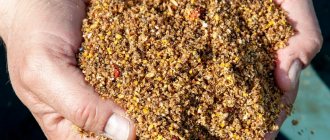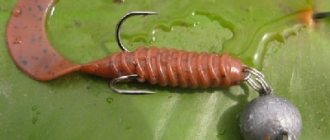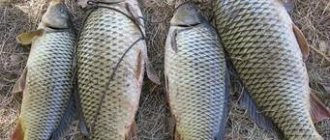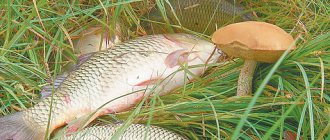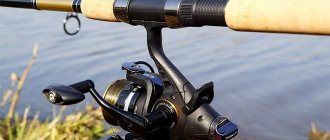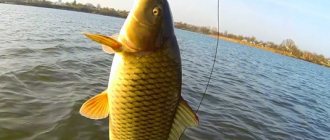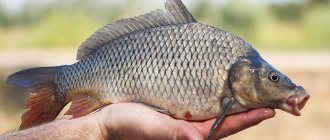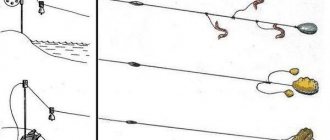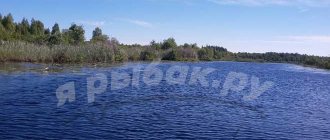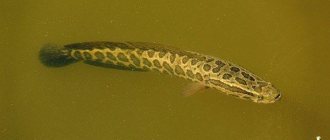Catching gear for carp
Summer fishing for carp is organized from the shore or boat. Based on the fishing method, a decision is made on what to catch carp in the summer. You can use different gear at the same time: mugs and a fishing rod for vertical fishing or a feeder with a float rod. Particular attention is paid to the equipment of the gear.
It should be taken into account that the gear for carp has no secondary elements.
Feeder for carp
Select a powerful feeder rod of the medium or heavy class with a medium action. Length – 3-4.5 m. Depends on the characteristics of the reservoir. On small rivers and small lakes (flooded quarries), it is convenient to fish with a 3-3.5 m rod. To catch carp on large (medium) rivers and reservoirs, you will need a long-range rod 3.5-4.5 m.
A high-quality reel should ensure laying of a fishing line (cord) with a length equal to the required casting distance + 15-20 meters. “Extra” meters may be needed when fishing for large carp. It is better to choose a spinning reel equipped with a baitrunner. It’s not always possible to expect a bite with an open line arc: side wind, current, etc. Before going fishing, you need to adjust the clutch. It should ensure that the fishing line is released under a load that is 2-3 kg less than the carrying capacity of the fishing line.
The fishing line must withstand a tensile load of at least 10 kg. It is better to install high-quality fishing lines that, with a smaller diameter, have the required load-carrying capacity. The line must be sinking. After casting, it lies on the surface of the bottom, and this is important when catching cautious fish. It is preferable to use a spinning cord with the same characteristics instead of fishing line.
The carrying capacity of the leashes is 1 kg less than the carrying capacity of the main line. The length of the leashes can be within 5-50 cm. Depends on the equipment. Short leashes are attached when the feeder is equipped with several feeders. Each angler chooses how to equip the feeder according to his wishes. Hooks No. 10 according to domestic numbering.
To catch carp, large feeders are selected for the feeder. The cells should ensure intensive leaching of bait.
Bite alarms are bells or bells. Bells are more practical as they can be easily attached to the rod tip using a built-in clothespin. At night, using several tackles, you can attach fireflies.
It is necessary to provide in advance a method for securing gear on the shore. It is convenient to use the industrial feeder stand. It provides for the installation of several gears. Single stands in which the handle is fixed are also suitable. To prevent the carp from pulling the rod out of such a stand with a sharp jerk, it is necessary to install it at an angle of at least 45 degrees, and when fishing on a slope of the coastline - at least 60 degrees.
Float fishing rod for carp
To catch carp in the summer from the shore or boat, float gear is successfully used. More often, fishermen find themselves in the hands of an affordable Bolognese fishing rod. At a distance from the shore it is convenient to fish with a match fishing rod. High quality fly rods are also suitable. The main requirements for fishing rods are high strength and ensuring casting to the required distance.
Inertia-free or inertial coils are selected.
A high-quality sinking fishing line is installed. The optimal option is 0.3 mm with a load capacity of 11.5 kg. The leashes are 10% thinner. Hooks No. 10.
The loading of the float plays an important role. The main thing is that it ensures timely detection of the onset of a bite. Along the way, crucian carp may bite, the beginning of which is characterized by great caution. To increase the casting distance, the float fishing rod is equipped with a sliding float. For night fishing for carp, fireflies are provided on a float.
Where to catch carp

The choice of place for catching carp often plays a key role. If the place is chosen incorrectly, then the probability of a bite is reduced to zero. Therefore, it is very important to know, at least approximately, what places the carp prefers to choose for its sites or shelters.
Carp is a schooling fish. It moves around the reservoir in schools, which consist of fish of approximately the same size. Its route usually changes rarely and often does not stray far from its permanent stopping places, so if you find a place where the carp bites well, it can please you with a catch for another year.
And it will be even better if you start feeding this place, regardless of whether you will fish on it in the coming days or not. The carp will get used to the fact that this place is rich in food and will visit it more often, spend more time on it and is unlikely to ever give up visiting it.
You should look for carp in such places as:
- depressions at river bends;
- deep sections of the river with a calm or reverse flow;
- holes with a depth of at least 3 meters;
- at the edge of algae in river bays;
- near the steep banks of a river with a depth of at least 3 meters;
- sections of the river with changes in depth;
- holes, whirlpools, flooded riverbeds;
- trees, branches, snags, flooded forests, stumps and other underwater shelters that have fallen into the water;
- The carp loves soft muddy soil; it is practically not attracted to sandy-stone soil.
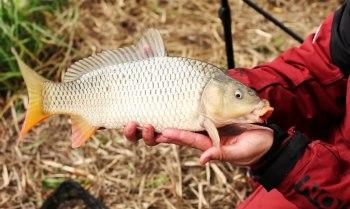
Basically, the carp always spins where there are deep holes, edges or depth changes. Moreover, there must be various obstacles for fishing gear nearby - submerged branches, trees, snags. Ideally, there will be thickets of reeds or reeds within a few hundred meters of such a site. Carp likes to go out there to hunt in the morning.
On small rivers, the carp stays in fairly deep places, but, again, next to drowned trees or snags. But the carp still comes out of its hiding places to feed. Of course, the closer the tackle is thrown to such snags, the higher the likelihood of a bite, but the likelihood of a hook also increases. It is optimal to cast at a distance that is safe for the gear, and attract the carp to your bait by feeding the area where your gear is cast.
When feeding the carp, take into account the strength of the current and the depth, otherwise your bait may be significantly carried away by the current and then the carp, on the contrary, will move away from your bait and feed further downstream.
When choosing a place to catch carp, never focus on the convenience of fishing. If you want to conveniently lay out your gear or park your car a few meters from the fishing spot, then you can go to paid ponds, where you can fish for carp with amenities and even gazebos and barbecues. Carp is a wild fish, it is very careful and does not tolerate unnecessary sounds. Carp does not like places where people often go - places for swimming, flat and comfortable banks on which people often fish.
You need to choose places where the carp feels calm, where people disturb it as little as possible. On a large river, of course, you can ignore this rule and simply make very long casts. But on small and medium-sized rivers, fishing near beaches is practically doomed to failure.
Conclusion! If you have no experience in determining where to catch carp, choose areas on river bends, holes, or places with flooded trees or snags. The depth at the fishing site must be at least 3 meters.
What does carp bite on in summer?
Throughout the summer, there is a good bite of carp on compressed cake briquettes. For fishing with cake, you can equip any bottom tackle. Tie a briquette of cake onto a metal plate attached to the end of the fishing line, into which stick hooks in the corners. If you use a lead plate, it will act as a sinker. When using a rod, select the weight within the test limits.
When going to a reservoir for carp, you need to take into account that there are not many different baits and plant attachments. It is impossible to predict in advance what carp will bite on in the summer on the day of fishing.
Popular vegetable baits for carp :
- Carp boilies;
- Prepared dough for fishing seasoned with vegetable oil. Preference should be given to vegetable and hemp oil. You can mix in crushed cake or ground roasted seeds;
- Specially prepared corn. Young corn does not require heat treatment;
- Boiled potatoes;
- Peas;
- Steamed pasta;
- Hominy;
- Steamed wheat.
Vegetable baits are attached to hooks separately or in combination with baits.
Catchable baits for carp :
- Red worms;
- Crawls;
- Maggots;
- Shellfish without shell;
- Caddisfly larvae;
- Bark beetle larvae;
- Bloodworms.
Together with baits, you can also use their silicone analogues. Small baits are baited or tied to the hook in a bunch. Small fish will most likely bite on one larva.
Carp biting calendar by season
Winter
- December. In the first half of this winter month, no bite is observed. In the second half, you can count on an average bite on days when floods begin and ice forms and breaks up.
- January. You can't count on successful fishing in January.
- February. In February the picture is the same as in the previous month.
Spring
- March. In the first half of the month you can’t hope for a catch, but in the second half, again during the flood period, you can count on a small bite.
- April. You can't expect a bite throughout April.
- May. In the first half of the month you can count on a small catch using a float rod. In the second, the fish begins to spawn.
Summer
- June. At the beginning of the month, although there will be a catch, it will be very meager. In the second half, you can catch a larger number of carp with a float rod.
- July. You can count on a good catch using a bottom fishing rod.
- August. The whole month will be “fishy”. Fishing with a float rod.
Autumn
- September. An excellent bite awaits you throughout the entire period.
- October. In October you can try bottom fishing, but the catch will be poor.
- November. In the first half of the month you can expect a bad bite, but in the second half there is nothing to count on.
Summer bait for carp
To attract and retain fish in the fishing area, summer bait for carp is used. It is unlikely that you will be able to satiate a voracious carp in the summer, so you should not skimp on the amount of bait.
Bait recipe for carp:
- Purchased mixture for carp – 1 part;
- Steamed wheat – 1 part;
- Bran – 1 part;
- Hemp grains or crushed cake – 1 part;
- Boiled or young corn – 1/10;
- Powdered milk – 1/10 part;
- Chopped worms or other crushed bait used - 1 handful per 1 kg of mixture;
- Flavoring for carp fish – 2-3 drops per 1 kg of bait;
- Salt – 1 pinch per 1 kg of mixture;
- A pinch of sugar or 2 tablespoons of honey per 1 kg of complementary foods;
- Water from a reservoir.
To impart the necessary viscosity, clay or fishing glue is used. The ingredients can be changed at your discretion. It all depends on the taste preferences of the carp in a particular body of water. The “work” of bait can only be checked by practical fishing.
Fishing methods
There are two fishing methods that can be used quite successfully to catch carp. This is a regular float rod and bottom tackle.
Float rod with running rig
The equipment received this name because it can be adjusted, that is, it does not have a “blind” fastening. Rods with running equipment are complemented by guides and a reel, which allows him to adjust the tackle.
For fishing with a fishing rod and running tackle you will need:
- Rod. A telescopic fishing rod made of carbon fiber is quite suitable. The optimal length will be 4-5 meters. For beginners, it is better to choose a fishing rod with a hard blank.
- Fishing line. The most suitable line is 0.2 mm in diameter. As a last resort, you can select a vein with a cross-section of up to 0.25 mm. Moreover, it will be better if you purchase a dull yellow fishing line. In a pond it will look as natural as possible.
- Coil. It can be either inertial or non-inertial. For beginners, an inexpensive wire reel will be enough to gain experience. The only condition is that it must have two brakes: adjustable and dead.
After purchasing everything you need, you can start collecting gear. First you need to wrap the spool with any rubber, the thickness of which is 1-2 mm.
Then secure the end of the fishing line and wind about 25 m of vein onto the spool. Pull it tightly, but avoid tension.
Next, tie a knot at the second end of the fishing line. This is where you will attach the leashes. Wind the entire remaining length onto the spool leg.
Wind some of the fishing line off the reel and thread it through the guide rings. Attach the weight and leash to the free edge of the fishing line. To the latter, in turn, tie a hook.
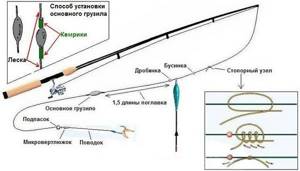
Bottom tackle
Bottom equipment consists of:
- Rods. It can also be a telescope made of carbon fiber. His test will depend on the current. In calm water it is better to use a rod with a weight of 40-60 g, and for rivers with large currents it is better to choose a rod with a weight of 100 g.
- Coil. Here the choice should be made in favor of a spinning reel with a spool size of 2500-4000.
- Fishing line. The thickness of the fishing line in this case will be the same. The same 0.2 mm.
- Feeder. Here the feeder performs two tasks: a container for feeding and a sinker. Choose the shape of the feeder depending on the pond. In calm water it can be different, both a cage and a spring. But in water with a strong current it is better to choose triangles or squares.
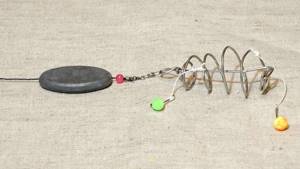
Catching carp in June
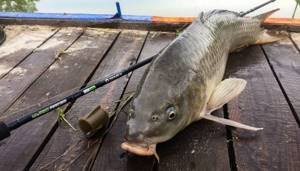
Fishing in June is influenced by the spawning of carp. Spawning begins after the water temperature stabilizes above 15 degrees. Spawning is long, as eggs are released in portions. In some regions it continues throughout June, and only carp that have not reached sexual maturity are caught. Males become sexually mature in the third year of life, and in favorable conditions grow up to 35 cm. Females are ready to spawn at 3-5 years of life. Before this, they can grow up to 45 cm.
During spawning, large carp refuses food and does not bite. During this period, schools of mature carp concentrate in shallow water.
During the spawning period, fishing for carp and carp is prohibited.
After spawning is completed and 10-14 days later, exciting carp fishing begins in June. After a long period of fasting, post-spawning gluttony begins. It is difficult for stomachless carp to get enough of it. At the beginning of summer, it eats large quantities of cattail and reed shoots, bottom larvae, aquatic insects, as well as the eggs of spawning fish.
The influence of atmospheric pressure on carp biting
You can track atmospheric pressure and changes in it using a weather forecast or using a home barometer, which is inexpensive. When the pressure rises, the weather improves, that is, it becomes clear. When the barometer goes down, clouds gather in the sky and hide the sun. These two weather conditions are called anticyclone and cyclone, respectively.
Changes in atmospheric pressure significantly affect the activity of any fish, and carp are no exception. It must be borne in mind that the movement of the barometer column up and down has a different effect on the behavior of carp in different seasons. This point must be taken into account.
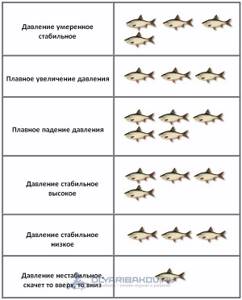
At what pressure does carp bite better in summer?
In summer, low pressure will be the best for catching carp and carp. This may seem strange to some, because they often say that in inclement weather the fish bite poorly. And low pressure corresponds precisely to bad weather.
The fact is that when the barometer rises, clear and sunny weather sets in. The water is strongly heated by the sun's rays. For the summer, this is a disadvantage, as the temperature becomes too high for the carp.
The fish will feel better and bite better in cloudy weather - days with little cloudiness, which delays the bright rays of the sun and allows the reservoirs to remain relatively cool. Once the high barometer needle begins to move down, you can expect an improvement in the bite.
Of course, this will only happen if weather changes occur smoothly. Sudden weather changes usually have a negative impact on fish behavior. The bite also worsens during prolonged bad weather.
Pressure for carp fishing in other seasons
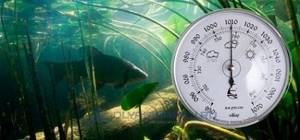
At this time, high pressure, which brings with it clear, sunny weather, also contributes to the activation of the bite. The water warms up well from the sun's rays, and heat-loving carp and carp begin to more actively look for food.
At the same time, you need to look for them at shallow depths. Where the bottom is no more than 2 meters, the water is very well heated by the sun during the day. The same situation can be observed at the beginning and end of summer.
In those reservoirs where carp and carp are caught in winter, the best bite at this time is facilitated, as in summer, by low pressure.
But here the reason is the opposite. If in summer at low pressure the temperature is lower, then in winter it is, on the contrary, higher. The cyclone brings with it warming. When the thaw comes, a wide variety of fish come to life. In such weather in winter, both carp and carp, as well as crucian carp, roach, perch, pike and other inhabitants of reservoirs, bite well. Important! Following general recommendations is not always enough for successful carp fishing.
Each region and each body of water has its own characteristics, which also need to be known and taken into account. You can master them through your own experience - the more you fish on this or that pond, lake or river, the more you will learn. Talking to local fishermen also helps a lot.
How atmospheric pressure affects fish biting, you will learn from this video:
Catching carp in July
In mid-summer you have to look for large carp. In extreme heat, the fish concentrates on the depths and moves little throughout the reservoir. Only a lack of food supply forces the carp to change its site. Activity increases at sunset, at night and at dawn. The most effective fishing for carp in July is at night. But it is difficult to determine in advance the hours of intense biting, so it is better to plan fishing for the whole night.
But this does not mean that catching carp in July during the day is futile. In coastal shaded cliffs it is caught with a float rod. This tackle is also convenient to use when fishing near the border of water lilies from a boat.
For fishing at a distance from the shore, a feeder is used. The effectiveness of fishing for carp in July is increased by the number of gears. But this should not be abused. The optimal quantity is 3-4 tackles. They are cast with a fan in such a way as to prevent the lines from overlapping during the process of landing a resisting fish.
When fishing with circles, 8-10 gears are set up. After the gear is laid out on the water, you need to observe it from a distance of 20-30 meters. Carp is a cautious fish, and excess noise can force it to leave even a well-fed place. Usually in July there is enough food even for the insatiable carp.
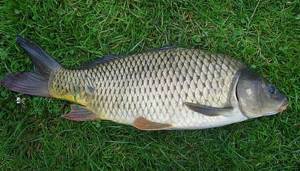
Features of fish behavior
Freshwater carp prefers to live in quiet, calm places with a clay bottom.
He is attracted to places with sharp changes in depth.
Carp prefers to stay in small flocks.
And despite the fact that the fish loves to play in the water, it will only catch food at the bottom of the reservoir.
Spawning of carp begins when the water temperature reaches 17 degrees.
As a rule, this happens in late May - early June. The fish prefers to lay eggs in places with high vegetation.
During the pre-spawning feast, the carp feeds on animal food, which is located on the ground and thickets, among which it lives, for example, mollusks, crustaceans or leeches.
In winter, the fish does not need feeding. Together with the entire school, it lies in the deepest parts of the reservoir.
It happens that on warm evenings the carp is not averse to frolicking on the sandbank. Early in the morning he goes out to the shore to feed.
Catching carp in August
In the first half of August, the carp behaves the same as in the middle of summer. During the first weeks of August, fishing for carp is preferable at night. If fishing is planned for several days or longer, then you should use bait. The bait can be delivered in a feeder or in a bag made of nylon stocking. The main thing is not to leave fabric bags at the bottom of the reservoir. The bait helps to increase the intensity of the bite during daytime fishing. There is no need to fuss over the ingredients of the bait. It is enough to chop the cake and scatter it on a promising area for fishing. These are deep areas with depth differences. It is better to deliver the bait closer to the bottom edge of the dump or to the entrances (exits) of the pits.
It should be noted that catching carp over a “bare” rocky bottom is a futile exercise.
From the second half of August, a gradual decrease in air and water temperatures begins. The sun often disappears behind the clouds and rain is not uncommon in August. This is an excellent period for catching carp in August, day and night.
On the eve of cold weather, fish begin to gain fat. But the carp's bite remains unpredictable. When going fishing, you need to replenish your arsenal with all kinds of bait and plant baits. To quickly determine what the fish like on the day of fishing, you should throw gear with different attachments (bait) on the hooks. Repeated bites on the same bait indicate that this bait should be preferred. After the next no-bite period occurs (more than an hour), continue experimenting with the existing baits and attachments. “Sandwiches” of bait and plant baits attract fish well.
So, with the correct preparation of gear for carp, attractive bait, a variety of baits and attachments, you can count on exciting carp fishing throughout the summer months. Interesting facts about carp can be found here.
About the carp "nipple"
Carp is an omnivorous fish.
It feeds on both animal and plant foods. But don’t think that by hooking whatever was at hand, you will catch a wild carp. The choice of bait must be approached very responsibly and knowledgeably. You can use a variety of gear for catching carp. Some people prefer a feeder, some prefer a regular donka, and some prefer a classic float rod. Let's look at where it is better to use which gear and how best to equip them.
Carp are usually caught in closed reservoirs: lakes, reservoirs and bays. In these places, the carp does not experience much competition and feels like a master. Therefore, we choose quiet reservoirs and feed promising points in the evening.
The most promising areas for night carp fishing will be places with depths of 2 to 4 meters, shallows, snags and coastal areas near overhanging trees. Carp likes to visit areas overgrown with water lilies and places surrounded by reeds.
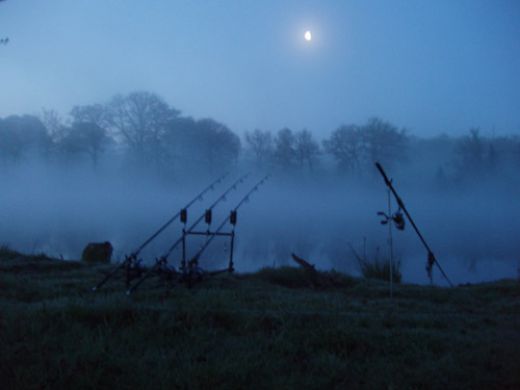
Since we will be fishing at night, we need to find a place where there are no bushes or trees nearby. In this case, casts will occur without snags and other unnecessary problems.
If there is a dam nearby, then there is a high probability that there will be a thermocline near it. In such places, the water temperature differs noticeably in different horizons. Carp often strives for those horizons where there is more oxygen. The exception is crucian carp. This fish thrives in the most unsuitable places for life.
Separately, it is worth mentioning the coastal area with overhanging trees. These places traditionally have a lot of food.
Here, for the fish, one might say, it’s an Eldorado. Beetles, caterpillars, a lot of leeches, larvae and worms fall from above.
There is constant shade during the day, and large fish naturally frequent these places. She knows that there is food here at any time and she can eat normally.
By the way, fishermen also love these places. In summer it is much more comfortable to fish near trees than to suffer in the heat.
True, not everyone understands how to fish. Many people cast their equipment further away into the middle of the river, where the water is warmed up as much as possible, and get almost no bites.
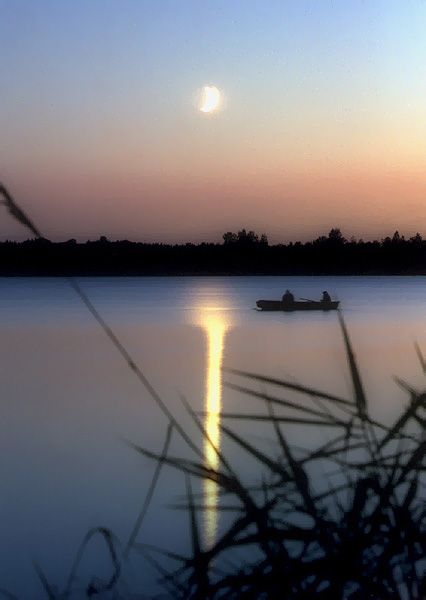
In hot weather, you should throw it in shady areas, where the fish look for coolness and food during the day.
In our case, the trees should be located on the opposite bank. If we fish on a narrow river or bay, then throwing a carp rod at the feeder will not be difficult. You should arrive for night fishing long before sunset in order to find places, have time to feed and lay out the necessary things.
It is very important to tap the bottom. It is necessary to determine the depths at the fishing points, the nature of the bottom and find clean places from snags and grass. At night, visibility is minimal, so it is extremely important to cast to clean areas.
You should make a decision about fishing in places near trees only after a detailed study of the bottom in that place. If we find a relatively clean area, then we make casts. If not, then we don't take risks.
In general, you need to find different points and throw one rig at each. It is not always clear where exactly carp concentrate in a body of water. In some places it comes out to feed on the reach, in the middle of the lake. In others, it visits the coastal dump, and in some reservoirs it is shallow, where the depth is no more than 1.5 meters.
If you know the reservoir well and spend time productively even when the bite is bad, then you know where to look for carp. A plus to this information will be detailed “interviews” with local fishermen. As a rule, they will tell you in detail how it used to be on the reservoir, what happened in past years and how things are going with fishing this season. Some will indicate the most promising carp places.
On an unfamiliar body of water, be sure to explore the bottom. Many people use a marker rod for this. They find edges, study the structure of the bottom, and measure the depth. You can learn how this is done from this article.
Of course, it's nice to have a wireless fish finder. With its help, you can not only find edges and study the structure of the bottom, but also determine the presence of fish and find out the water temperature in different parts of the reservoir.
On the river, the exits from the pit are considered promising areas. If the bottom is shell-like, then there should be plenty of food there. Competition among fish there is high. But when the carp comes to the point, all the little things go away.
After finding 3-4 promising points, we begin feeding. These points are located at a decent distance from each other. For example, one is located at the exit from the pit, the second is on the lower slope, the third is in a shallow area, and the fourth is near the opposite bank, near overhanging trees.
Particular attention should be paid to points located near the shore. The bottom should be tapped more thoroughly.
Carps love to visit coastal dumps. If you find a place where the depth increases sharply, be sure to add it to your list.
Feed him thoroughly and cast your line at night. Often this is the place that turns out to be the most “profitable”.
It happens that during the night you can catch 5-6 carp, as they say, under your feet.
After choosing a place, we begin to settle in. We install rod pods, check alarms and fireflies. Be sure to lay out the landing net and place it next to the chair so that it is at arm's length. It is better to use a landing net with a long handle and a large head.
You need to immediately prepare flashlights: a headlamp and one with a stand. We prepare baits and baits. We determine the location for the cage and install it immediately.
If you are planning a fire at night, it is better to find a place for it a little away. Carp are quite cautious and can be afraid of fire.
We are preparing tools for delivering bait: slingshots, cobras, large feeders and other devices. You should also take care of warm clothes and necessary products. All this should be within reach.
We pay special attention to products. In hot weather, it is better to eat perishable foods immediately or store them in thermal bags.
We always store animal baits in the shade in spacious boxes with ventilation.
If you are going to fish for several days, you should set up your tent. Many anglers use a small travel cot or air mattress. These items will provide you with a comfortable sleep.
Upon arrival at the place, you must immediately feed the places. The faster you do this, the faster you will collect carp at the fishing point. You can also count on the evening bite.
Bait should be high-calorie and flavorful. It is better to use boilies, canned corn, boiled potatoes, cake, peanuts, boiled pearl barley, store-bought formulations and, of course, dips, liquids, sprays and other aromatics.
Carp is very fond of fruit and chocolate liquid additives. They are added directly to the bait. In hot weather, strawberry, raspberry, vanilla, chocolate, plum and melon boosters and liquids performed well. If you have fruit essences, you can add a little to the water and get a pleasant-smelling liquid.
Before feeding, the boilies are kept in boosters and liquids, and soft, aromatic balls are obtained. You can soak some boilies in fish oil, hemp and linseed oil and add them to the bait. Very often, such mixtures attract carp and literally tie it to the point.
If a promising point is located among algae, then PVA bags can be used. The bait is stuffed into them, and next to it there is a hook with a nozzle. The bag gradually dissolves and the bait slowly comes out. There are two types of bags: solid and with mesh.
They dissolve at different rates. Before casting, you can place the hook with the bait inside the bag. Thus, the likelihood of the hook catching on the grass will be minimized. After hooking, the carp can be removed from the grass.
Bait for carp is rolled into balls. It is very important to add grains to the composition: corn, peas, pearl barley, steamed wheat.
Boiled potatoes are also a very good food. Some fishermen knead it to the state of porridge and add unrefined sunflower oil with a rich aroma of seeds.
You can also add pellets and cake to this mass and you will get a very high-calorie bait. Carp cannot resist it.
Always have a gas burner with you when fishing at night and several kilograms of peas and pearl barley. Sometimes extra pounds of cereal prolong the fish’s bite. This especially applies to peas. It is better to use half and half as it cooks faster.
They are usually fed with rockets (spombs), a slingshot or a parachute. They roll a lot of balls and deliver them to the points.
When fishing for carp, it is best to use method feeders and hair equipment. The methods work best in stagnant bodies of water. They fly well, hold a lot of food, and the bait is washed out evenly and is available to the fish immediately after casting.
What baits and components are used for carp fishing can be found in our articles.
Starter feeding is 60-70% of groundbait. It’s better to make some noise right away, and then fish in silence. You should feed with 2-3 balls during the fishing process. Depending on the situation, we select the frequency. But it is better to do this at intervals of 1.5 - 2 hours.
Since we are going to fish at different distances, we will use carp baits or powerful feeders, and float rods. We will cast the first ones at long distances, and the fishing rods at short distances. There is virtually no noise when casting a fishing rod. The long length of the rod allows you to catch even large specimens.
We install carp fish and feeders on rod pods or large tripods. If there are no such stands, then we place the rods on single stands at a distance of a meter from each other. We place fishing rods on single stands. You can cast two fishing rods and three donks.
You need to come to fishing well-rested. At night, carp can bite in different ways. In some cases it is active from 12 to 3 o'clock. In others, the pecking begins just before dawn. In the middle of summer, it is almost impossible to understand when the carp bite will begin. Therefore, you should stay near the fishing rods all night.
As an option, you can use a soft folding chair, which is comfortable to lie on, and put electronic alarms on the fishing rods. During a good bite, a loud sound should wake you up.
But it’s better not to sleep. It happens that the number of bites can be 2-3.
But these are bites from large fish. If you don’t hook it in time, the carp will get the tackle into snags or grass, and it will be impossible to get it out.
Of course, it can be difficult to sit all night waiting for bites. But you don't have to sit.
You can vary your fishing a little. For example, catching another white fish with an elastic band.
It is enough to step a little to the side and cast the tackle. Let the carp fishing rods be on the alarms at this time, and at this time you can quietly catch bream, crucian carp and roach.
The main advantage of the elastic band is its noiselessness. All you need to do is quietly place the baits on the hooks and carefully send the elastic into the water.
It is very important to take aim before dark. It is necessary to remember the points where you should throw the feeders.
To accurately hit the same place, we fix the fishing line on the spool with rubber bands. We mark the place of fixation with a bright marker.
A meter of fishing line must be painted over. When casting, the line will go down to the fixation point.
After sharp pulls, the line will be released by the clutch or baitrunner. The fishing line may slip off the elastic.
To restore the previous range, we find a painted area of wattle or fishing line and place it under the elastic band on the spool.
In the evening, you should arrange everything correctly, repeatedly cast the gear, and fill your hand so that you can cast automatically at night.
If one of the points is in shallow water, then pay attention to whether there are bubbles on the surface of the water. Their presence is a sure sign that carp are present. As a rule, such zones are located near the coast. Fishing in such places is necessary only with a fishing rod. It must be powerful, have a front drag reel with a spool size of 5000.
If the shallow water area is located at a decent distance, then you should use a match fishing rod with a rigid action and a test weight of 10-20 g. This rod will allow you to make long and accurate casts.
It is clear that not everyone is able to make accurate casts at night. If you see that the tackle is lying to the right or left of the point, then use large PVA bags. This way you will be sure that a sufficient amount of bait is always present near the bait with a hook.
When fishing with fishing rods, we attach fireflies to the float. You can use a cambric or a transparent tube that comes with the fireflies.
A very effective tactic is to use different baits and baits on different fishing rods. Most often, this method is used when fishing in paid reservoirs.
It happens that carp are caught only on corn in plum dip. Or it only bites on large boiled peas and feeds on pellets.
Therefore, we put corn on one fishing rod, potatoes or barley on another, and boilies with different flavors on the third and fourth. A good option is a combination of corn and worm.
Be sure to adjust the clutch on each reel and if there is a baitrunner, then set it to the working position.
It happens that at first only one point works. For example, carp can only be caught well in shallow waters.
This does not mean that it will continue to be so. We continue to fish at the same points.
It often happens that after a few hours other points begin to work, and where there was a bite, everything calms down. All preparation should take place during daylight hours.
You shouldn't change points at night. All you have to do is wait and try different dips and baits.
Finally, the first good vole occurred, and we managed to spot a good carp. What to do in this case? We turn off the baitrunner, if there is one, and see how the clutch works. If it rotates a lot, then tighten it a little so that the fish gets tired faster. If the clutch rotates slowly, then loosen it a little.
Let's look at the situation. It’s good when the reservoir is spacious, there are not many reeds and no snags.
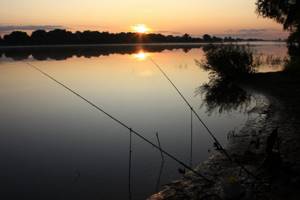
Our task is to let the carp have plenty of fun, and then begin to fish it to the shore. It is more difficult if the space for maneuver is limited and the coastline is covered with reeds.
In this case, you will have to work with the rod and tighten it a little tighter with the clutch. When the carp tries to go into the reeds, you should make a reverse movement so that it feels the force.
After this, you should bring it a little to a clean area of the reservoir and loosen the clutch, let it walk a little. It is easier to catch carp with a powerful rod.
He, feeling the strength, no longer tears the tackle so violently.
When we manage to bring the fish closer to the shore, we pay maximum attention to the last meters of the distance. If there is a reed near the shore, then the carp will definitely want to swim closer to it. Even medium-sized crucian carp do this. Under no circumstances do we allow the carp to go into the reeds. Tight control, hope for the strength of the tackle and a rod that absorbs jerks well.
When there are a few meters left to the shore, we take out the landing net, put it in the water and put fish in it. No need to help with a landing net. First we start it, and then we take it ashore.
Good fishing online stores will allow you to purchase any fishing goods at competitive prices!
The fisherman's calendar will allow you to understand how all the fish bite depending on the time of year and month.
The fishing gear page will tell you about many popular gear and devices for fishing.
Fishing baits - we describe in detail live, plant, artificial and unusual ones.
In the bait article you will get acquainted with the main types, as well as tactics for using them.
Learn all the fishing lures to become a real fisherman and learn how to choose the right one.
Main ingredients in the bait
The preferences of carp will vary depending on the time of year. Therefore, it is so important to know when and what bait should be used.
Summer
At this time of year, you should not use animal bait, as due to the heat it begins to deteriorate and scares away the fish. In summer, it is better to give preference to ingredients such as oatmeal, wheat flour, sunflower or flaxseed cake, and crackers. To make the mass sticky, use oatmeal.
Autumn
For autumn fishing, bait made from the following ingredients is ideal: boiled pearl barley, carrots, rice, bran, hemp seeds.
You can also use animal bait in the fall. For example, a ground worm can serve it. It is also worth adding anise oil. This will attract fish.
Winter
In winter, it is also better to use plant foods. For example, semolina in combination with potatoes can serve it. Add vegetable oils to flavor the bait. And for stickiness, use oatmeal.
Spring
In spring, carp are attracted by the aroma of the worm. Therefore, it is highly recommended to add it to the bait. But strong odors should be avoided. For example, onions and garlic will only scare away fish. Carp will also be attracted by the cheesy smell in the spring.


